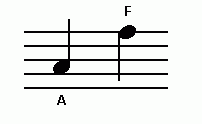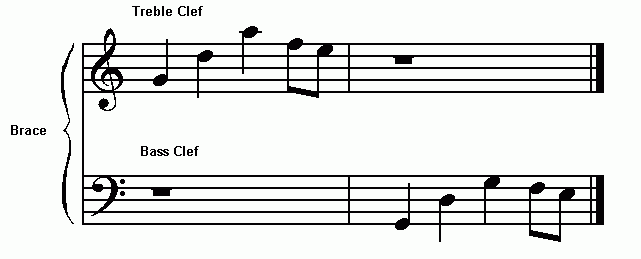Section 2: Pitch
As simple as a definition can be, a Pitch is a specific musical tone. There are several notes that you hear when you listen to music. Some are higher and some are lower. Each separate note has a specific tone or pitch. See figure B.

Figure B (Pitches)
The first note indicated in Figure B is an A because it rests on the space that is used to represent an A. The second note is an F. It is important to note that physically, the F is higher on the staff than the A. It is quite obvious that there are many more notes that can fit onto the staff, but when you hear music, there is a vast range of notes.
If the staff was all there was to music, then you would only have the eleven notes that fit onto it. Those eleven notes would be the five lines, and the six spaces, (the four spaces between the lines, and the two spaces above and below the top and bottom lines).
There are two different staves commonly used in music composition. Each one represents a different range of pitches.
Clef: A symbol indicating the pitch represented by one line of a staff, in relation to which the other pitches of the staff can be determined.
The top staff is called the Treble Staff and the bottom staff is the Bass Staff. If you listen to the notes on the two staves you will soon know why. Pitches on the Treble staff are higher and the pitches on the bass staff are lower. The musician or the songwriter knows which is which by the symbol that is placed on each. This symbol is called a clef. A Grand Staff is formed when two staves are grouped together by another symbol called a Brace, (see Figure C).

Figure C (A Grand Staff)
In Figure C, the notes you are looking at on the different staves are in fact the same notes. If you look a little closer you can also see that they are not on the same lines. This is because the lines and spaces for the Bass clef are named differently from the Treble clef, (see Illustration A).

Illustration A. (Comparing Treble & Bass clefs)
NOTE: It is important to note that the relationships between the notes on the different staves are important to learning how to read music in ANY clef. We will introduce the other two clefs as you advance through this course.
An easy way to remember the Bass clef is with the catch phrase Good Boys Do Fine Always to name the lines, (from bottom to top), and All Cows Eat Grass to define the spaces between them, (again from bottom to top).
Combining the two staves, you now have the ten lines and eight spaces, plus the four spaces above and below each staff giving you a total of twenty two notes, (See Figure D).

(Figure D)
Another way that notes are added is by the use of "ledger lines" or extra lines added above and below the staff, (See Figure E).

(Figure E)
There are as many ledger lines added above the Treble staff and below the Bass staff as are needed to identify the instrument you are writing for. The ledger line between the Bass and Treble clefs represent a single note between the two staves called Middle C.